In the 1980s our future king spent a week crofting in Scotland. Ensconced in a farming community on a small Outer Hebridean isle, his host remembers his visit well…
MORE FROM SCOTLAND MAGAZINE
If for some reason you don’t feel other islands in the Outer Hebrides offer sufficient solitude, then Berneray, barely more than a raised belly button in the Sound of Harris, is the place for you. Two vast shell-sand beaches stitch a twinkling silver membrane along the island’s flanks, illuminating even those (frequent) days when a steely grey sea is mirrored by skittish clouds the colour of liquid metal.
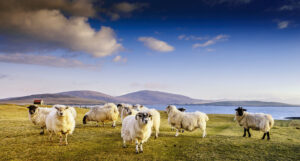
A couple of hills make for an undulating, grassy interior, while a tight-knit, if dispersed, community of just 140 people call the island, two-miles-wide, two-miles-long, home. In 1987, one high-profile individual in search of solitude and an induction into island life certainly found what he was looking for here. For that was the year this tiny island hosted the-then Prince of Wales (or Duke of Rothesay in Scotland), the future King Charles III. And the outside world remained oblivious until he was gone.
The crofter-prince spent a week on Berneray, staying with Donald Alick ‘Splash’ MacKillop and his wife Gloria, who gave him an introduction to the daily routine and chores of crofting, planting and lifting potatoes, cutting peat, and dipping sheep. The visit emerged out of an earlier trip to the Outer Hebrides by Charles and Princess Diana. “At the time of that visit we weren’t aware of the concerns about their marriage,” recalls Gloria. “It was just lovely to see them. They arrived by helicopter, [and] we all followed them down to the school.” A few days after the couple left, royal of officials got in touch: “Apparently once a year Charles liked to go to an isolated part of the UK to discover how life was lived,” says Gloria.
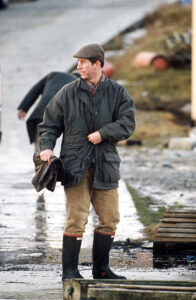
Charles’s stay had historic echoes: he was then Lord of the Isles – a title originating in the 12th century. Since 1493 the title has been held by the eldest son and heir apparent of the King of Scotland – and, since the creation of the Kingdom of Great Britain, of the reigning monarch.
Charles stayed in the MacKillops’ house, at 2 Borve, later renamed Burnside Croft, sleeping in a small room on the second floor. “We joked it was the size of a cupboard at Balmoral, but it was a wee bit bigger than that,” says Gloria, who would wake the prince with a knock on the door. Often Charles was already downstairs, “ready to be a part of Berneray life. He just became part of our lives,” she says. “He wanted to meet as many people on the isle, to learn how people made a living from farming,” Gloria explains.
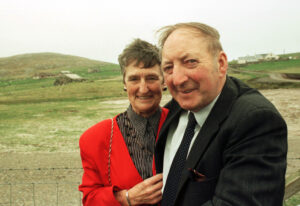
“We have a wonderful community here and it reached out to him. He was struck by how everyone had at least two incomes, such as fishing and farming.”
Berneray is fertile – rare for the Western Isles there’s no peat here – and potatoes grown here were grown historically and specifically to feed the island of Harris. “He was really fascinated by the crofters, the way they used seaweed, sand and grass,” says Gloria. “Their approach to farming seemed to be in tune with many of his own ideas for organic agriculture.”
Charles is reported to have put his experiences crofting in Scotland to use on his organic farm at Highgrove in Gloucestershire.
An unwritten vow of silence that would make the Mafia Omertà seem garrulous applied across the island during Charles’s stay. “No one knew he was coming,” says Gloria, “Splash would just walk into someone’s house with Charles and say, ‘I’ve got a visitor’”.
“People who met him came away with a very different impression from what you might see on television. In the evenings we would chew the cud, there was conversation and laughter. He saw all of life – my husband and the other crofters made sure of that; they didn’t hold back.” Gloria recalls a cèilidh where whisky was sunk, and Charles ate the island’s take on cranachan (oatmeal, seaweed, raspberries, cream, and whisky). “Everyone took turns to sing a song,” she laughs. “He could be naughty, too, he would wolf down the tatties and mince and take the tatties off other people’s plates.”
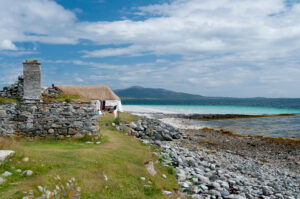
The prince, tongue thoroughly loosened, joined in and held forth with a ditty that began “Auntie Mary had a canary…” before being interrupted by his ever-vigilant private secretary unsure just where the lyrics were leading. Charles returned to Berneray in 1991 to make a BBC documentary with Selina Scott, A Prince Among Islands, about his earlier stay and took his canvas to paint the late afternoon and evening landscapes. In 1999, he opened a causeway linking the island to North Uist. Famous for his trenchant architectural views, the prince praised the way the structure blended into its setting and the incorporation of culverts for otters, fish, and seals. Splash died in 2009 aged 78 and in a heartfelt tribute, Charles said that “people like him are very hard to replace”.
Today’s traveller to Berneray will find the same spirit of hospitality. Were he so minded, the King could stay at either of two youth hostels. As Peter Clarke, chair of the Gatliff Hebridean Hostels Trust, says: “The door [on Berneray] is never closed; our hostel is open all year round. You may have the place to yourself, or you could walk in on a party”.
Those magnificent West and East beaches invite hours of exploration and are backed by machair that is home to orchids, poppies, buttercups, butterflies, and bees. The colonies of harbour and Atlantic grey seals in Bays Loch, just to the north of the harbour, haul out for a photogenic breather at low tide.
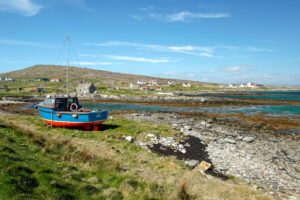
A 10-minute walk up The Hill of the Graveyard (Beinn a’ Chlaidh) leads to Clach Mhòr, a standing stone 2.5m above ground. On the flanks of the hill lies Tobar Leathad Ullaraidh (The Well on the Hillside). The water taken from this well was considered the most pure and fresh on the island and was used for both christenings and distilling whisky. The oldest surviving building is the sturdy 16th-century Macleod’s Gunnery, once the home of an eponymous knight. Close by is a cluster of traditional blackhouses, some now restored.
This is an extract. Read the full feature in the January/February 2022 issue of Scotland, available to buy from Friday 16 December.
MORE FROM SCOTLAND MAGAZINE

SCOTLAND MAGAZINE
Published six times a year, every issue of Scotland showcases its stunning landscapes and natural beauty, and delves deep into Scottish history. From mysterious clans and famous Scots (both past and present), to the hidden histories of the country’s greatest castles and houses, Scotland‘s pages brim with the soul and secrets of the country.
Scotland magazine captures the spirit of this wild and wonderful nation, explores its history and heritage and recommends great places to visit, so you feel at home here, wherever you are in the world.